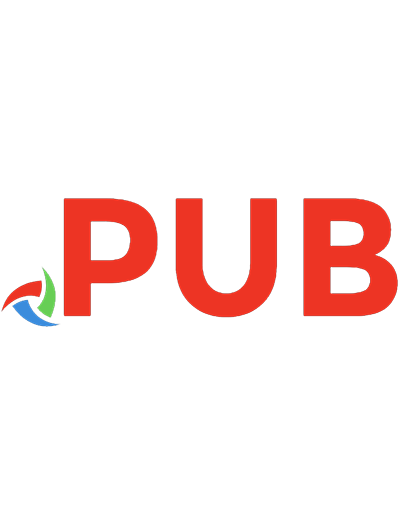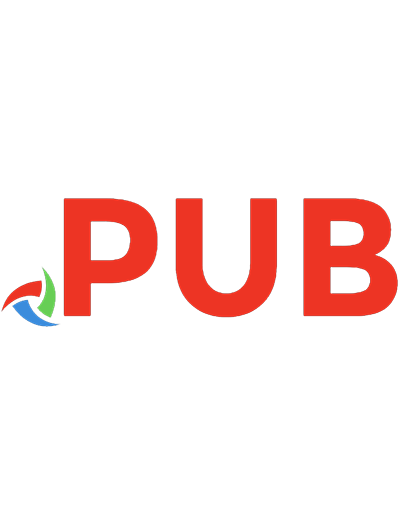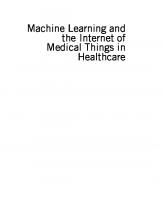Internet of Medical Things for Smart Healthcare: Covid-19 Pandemic 9811580960, 9789811580963
This book covers COVID-19 related research works and focuses on recent advances in the Internet of Things (IoT) in smart
562 76 14MB
English Pages 305 [312] Year 2020

- Author / Uploaded
- Chinmay Chakraborty
- Amit Banerjee
- Lalit Garg
- Joel J. P. C. Rodrigues
- Categories
- Medicine
Table of contents :
Preface
Contents
Editors and Contributors
Transmission Dynamics and Estimation of Basic Reproduction Number (R0) from Early Outbreak of Novel Coronavirus (COVID-19) in India
1 Introduction
2 Materials and Methods
2.1 Serial Interval
3 Results
3.1 Analysis of COVID-19 in India
3.2 Forecasting Near-Future Incidences in India
3.3 Analysis of COVID-19 in States and UT of India
4 Discussion
References
COVID-19 Analysis by Using Machine and Deep Learning
1 Introduction of Machine Learning and COVID-19
2 Literature Review
3 Data Collection and Preprocessing
4 Algorithm Used
5 Result and Discussion
References
MML Classification Techniques for the Pathogen Based on Pnuemonia-nCOVID-19 and the Detection of Closely Related Lung Diseases Using Efficacious Learning Algorithms
1 Introduction
2 Recent Pandemic
3 Pneumonia Infection
4 Pneumonia with COVID-19
5 Related Literature in ML with Healthcare
6 Roles of Machine Learning
6.1 Supervised Learning
6.2 Unsupervised Learning
6.3 Semi-supervised Learning
6.4 Reinforcement Learning
6.5 Neural Networks Learning
7 Methodology
7.1 Naïve Bayes Classifier
7.2 Random Forest
7.3 Linear SVC
7.4 Feature Selection
8 Experimental Setup
9 Publications Relevant to ML and DL for Medical Imaging
10 Conclusion and Future Work
References
Diagnosing COVID-19 Lung Inflammation Using Machine Learning Algorithms: A Comparative Study
1 Related Work
2 The Proposed Approach
2.1 Preprocessing of CT Images
3 Classification of COVID-19 Pneumonia Level
4 Traditional Classification Methods
5 Infected Lung Severity Level
6 Experimental Setup
7 Results and Discussion
8 Conclusion
References
Factors Affecting the Success of Internet of Things for Enhancing Quality and Efficiency Implementation in Hospitals Sector in Jordan During the Crises of Covid-19
1 Introduction
2 Research Background
3 Theories and Models of Successful IS Implementation
3.1 IS Success Theory
3.2 Information Systems (IS) Effectiveness Concept
3.3 Extended of Information Systems (IS) Success Theory
3.4 Systems Dynamic Theory of Information Systems (IS) Success
3.5 Sabherwal’s Theory
3.6 Information Systems-Impact Success Theory
3.7 Information Systems Success Research
3.8 Summary of IS Success Theories
3.9 Research Factors
4 Research Methods
4.1 Data Collection Method and Framework
4.2 Research Framework and Hypotheses
4.3 Instrument Design
5 Reliability of Measuring Instrument
5.1 Data Screening and Cleaning
5.2 Profiles of Respondents for Actual Data Collection (N = 417)
6 Data Analysis
6.1 Validity the Measures
6.2 Testing the Research Model
6.3 Testing Robustness
7 Research Contributions
7.1 Methodological Contribution
7.2 Theoretical Contribution in Research
7.3 Practical Contributions
8 Research Implications
9 Conclusion
10 Recommendations for Future Research
References
IoMT-Based Smart Diagnostic/Therapeutic Kit for Pandemic Patients
1 Introduction
2 Pandemic Diseases—Symptoms and Treatments
2.1 Coronavirus Disease 2019 (COVID-19)
2.2 COVID Symptoms
3 Application of IoT in Health care
3.1 IoT-Based PCR for the Identification of Pandemic Disease
3.2 IoT for Smart Health care
3.3 IoT-Based Wearable Smart Health Monitoring System
4 Telemetry Principles
4.1 Wireless Radio Telemetry
5 IoMT Framework for Pandemic Patients
5.1 Components in the Smart Kit Design
5.2 Processing Unit
6 Conclusion and Future Work
References
The Prediction Analysis of COVID-19 Cases Using ARIMA and KALMAN Filter Models: A Case of Comparative Study
1 Introduction
2 Predictive Modeling
3 Time Series Using COVID-19 Datasets
4 ARIMA
4.1 The Notation of ARIMA (P, D, Q)
4.2 ARIMA in COVID-19 Cases—Datasets
4.3 ARIMA Model on COVID-19—India Dataset
5 KALMAN Filter
5.1 KALMAN Filter—for Prediction in Different Studies
5.2 KALMAN Filter—for COVID-19 Prediction—India Dataset
6 Geographic Information Systems—Visualization and Prediction—COVID-19 Datasets
7 Conclusions
References
Exploration of Cough Recognition Technologies Grounded on Sensors and Artificial Intelligence
1 Introduction to Sick Sound—COUGH
2 Cough Pattern Phases
3 Features of Cough
4 Methods and Algorithms Deployed for Cough Detection
5 Instruments Organized in Cough Detection
6 Parameters Achieved in Cough Detection Deployment
7 Dataset Details for Cough Detection
8 Conclusion
References
Clinical Deep Dive and Role of Ai/Ml Techniques in Tackling COVID-19
1 General Introduction on COVID-19
1.1 Morphological Structure
1.2 Genomic Characteristics
1.3 Coronavirus Spike Protein
1.4 Spike—Receptor Interactions
2 Mode of Transmission
2.1 Clinical Symptoms
3 Evidence for Natural Evolution
3.1 Possible Origin of Virus
4 Mechanism of COVID-19
5 Diagnostic Test
6 New Antivirals
6.1 Antisera and Drug Repositioning
6.2 The Long-Awaited Vaccine
7 “Times of India” Report
8 Role of Artificial Intelligence (AI) & Machine Learning (ML) Applications in COVID-19 Times
8.1 Role of AI/ML During COVID-19 Times
9 Prevention
10 Treatment of Coronavirus-Covid-19
References
A Review on Use of Data Science for Visualization and Prediction of the COVID-19 Pandemic and Early Diagnosis of COVID-19 Using Machine Learning Models
1 Introduction
2 Key Concepts
2.1 Data Science
2.2 Machine Learning
2.3 Artificial Intelligence
2.4 Statistics
3 Contributions of AI and Data Science Against COVID-19 (Actual and Potential)
3.1 Visualization of the Pandemic
3.2 India’s COVID-19 Tracker
3.3 What Do All These Have in Common?
3.4 Major Technologies Used
4 Early Detection and Diagnosis
5 Early Warnings and Alerts
6 Tracking and Prediction
6.1 Clustering
7 Patient Outcome Prediction
8 Fake News and Misinformation
9 Treatment and Cure
10 Resources for Data
11 Conclusion
References
Fuzzy Cellular Automata Model for Discrete Dynamical System Representing Spread of MERS and COVID-19 Virus
1 Introduction
2 Basic Concepts
2.1 Cellular Automaton
2.2 Fuzzy Set, Fuzzy Number, α-cut
2.3 Fuzzy Cellular Automaton
3 Fuzzy First-Order Difference Equation & Its Solution
3.1 Solution of FFDE When λ Is Constant and tildey0 Is a Triangular Fuzzy Number
3.2 Solution of FFDE When y0 Is Constant and the Parameter λ Is a Fuzzy Triangular Number
3.3 Solution of an FFDE When λ Is Time Dependent and tildey0 Is a Triangular Fuzzy Number
3.4 Solution of an FFDE When λ Is Time Dependent and Is a Triangular Fuzzy Number Whereas y0 Is Crisp
4 CA Models for First Order FDE and FFDE
4.1 First Order FDE and CA Models
4.2 First Order FFDE and FCA Models
5 Output and Results
5.1 Fuzzy Model Representing Growth-Trend of the Number of Virus-Infected People Within a Short Span of Time
5.2 Fuzzy Model Representing Spread of Virus over a Considerably Large Period of Time
6 Conclusion
References
Author Index
![Internet of Medical Things for Smart Healthcare: Covid-19 Pandemic [1st ed.]
9789811580963, 9789811580970](https://dokumen.pub/img/200x200/internet-of-medical-things-for-smart-healthcare-covid-19-pandemic-1st-ed-9789811580963-9789811580970.jpg)
![Cognitive Internet of Medical Things for Smart Healthcare: Services and Applications [1st ed.]
9783030558321, 9783030558338](https://dokumen.pub/img/200x200/cognitive-internet-of-medical-things-for-smart-healthcare-services-and-applications-1st-ed-9783030558321-9783030558338.jpg)

![Efficient Data Handling for Massive Internet of Medical Things: Healthcare Data Analytics (Internet of Things) [1st ed. 2021]
3030666328, 9783030666323](https://dokumen.pub/img/200x200/efficient-data-handling-for-massive-internet-of-medical-things-healthcare-data-analytics-internet-of-things-1st-ed-2021-3030666328-9783030666323.jpg)

![Internet of Things for Healthcare Technologies [1st ed.]
9789811541117, 9789811541124](https://dokumen.pub/img/200x200/internet-of-things-for-healthcare-technologies-1st-ed-9789811541117-9789811541124.jpg)



